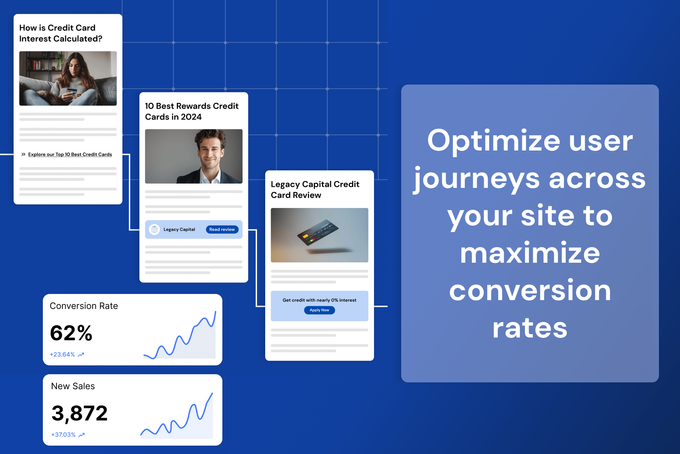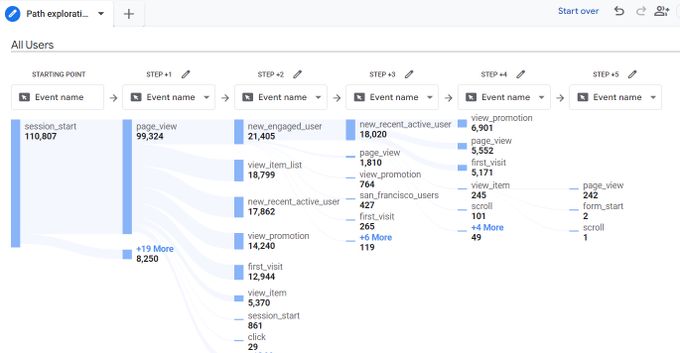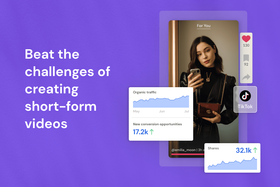User journey optimization: A guide to increasing conversion rate
Learn how user journey optimization can help reduce churn, boost conversion rates, and improve user experience.
Updated March 27, 2025

Improving user journeys on your site is essential if you want to reach your marketing goals. Optimizing the user journey can significantly reduce churn, improve user experience, and increase conversion rates. However, it requires a holistic approach to understanding and shaping how users engage with your website from start to finish.
Key takeaways
- User journey optimization is relevant to large websites with significant traffic.
- User journey optimization can reduce churn on your website and dramatically increase conversion rates.
- User journey optimization involves tracking traffic and user interactions, analyzing data, and being able to manipulate pages by adding calls to action (CTAs).
- Because of the enormous number of possible paths a user can take, it's impossible to automate user journey optimization without the right software.
What is the user journey?
The user journey is the complete experience a user has while interacting with a product or service, from awareness to goal completion and post-purchase interactions like retention and advocacy.
In general, there are five user journey stages:
- Awareness: The user becomes aware of a brand or product.
- Consideration: The user starts researching and evaluating the product or service.
- Decision: The user decides to purchase the product or service.
- Retention: The user stays engaged and satisfied with their purchase, potentially leading to additional purchases and brand loyalty.
- Advocacy: The user is satisfied and recommends the product or service to others.
» Optimize user journeys across your website with Entail.
What is user journey optimization?
User journey optimization is the process of tracking and improving how users move through your website to complete their goals. It involves monitoring user interactions with different touchpoints on your site and changing CTAs and page elements to increase the number of users who complete your marketing goals. These goals can include purchasing a product, booking a demo, downloading a guide, or any valuable action you'd count as a conversion.
User journey optimization is relevant to websites that have significant traffic and a large number of pages.
User journey optimization vs. customer journey optimization
I've noticed the terms user journey optimization and customer journey optimization get mixed up often, but they're not exactly the same thing.
User journey optimization focuses only on website interactions and tracks users' movement through your web pages. On the other hand, customer journey optimization is typically used by B2B companies and includes a broader range of touchpoints outside of your website. For example, it may also involve interactions with sales reps, reference customers, and other external factors.
» Optimize customer journeys across your site with customer journey mapping.
Opportunities and challenges of user journey optimization
The opportunity in user journey optimization lies in improving conversion rates by showing users the right CTAs at the right time based on their intent, traffic source, and user profile. This can significantly increase conversions across multiple pages and traffic sources.
The challenge is complexity. Let's say your website has a thousand pages with 50 different links each, including header and footer navigation, contextual links, and CTAs. With an average of five steps per journey, the number of possible user journeys becomes astronomical—about 319 billion, according to ChatGPT. This makes manually tracking and optimizing user journeys virtually impossible.
» Book a consultation to find out how you can optimize the user journey automatically.
How to track and analyze user journeys on your website
Tracking user journeys on your site relies heavily on analytics, but it's not enough to track what users click on. The key is tracking funnels to understand how users move through specific flows on your website.
But how do you track so many user journeys?
Analytics tools
One answer is to use analytics tools to build funnels for the main journeys on your website and focus on only optimizing those. Analytics tools like Mixpanel allow you to map anywhere between 2 and 10 stages to track user interactions. You can then work on improving each step individually as well as the entire funnel. However, this limits you to optimizing a relatively small number of funnels.
Heatmaps, session recordings, and analytics reports
Another option is using traditional methods like heatmaps, session recordings, and analytics reports. However, these are qualitative, not quantitative, limiting you to understanding specific users instead of user journeys in general. You also can't use these methods at scale, so they won't work if you have a lot of traffic and pages on your site.
User flow reports
You could also use user flow reports or path exploration reports from Google Analytics, which show user paths and drop-off points. However, I find that these reports are usually a complete mess, especially when users move back and forth between pages. Not only that, but the data can be overwhelming, making the reports difficult to analyze.
User journey optimization software
If you want to track multiple user journeys, hundreds of different CTAs, and page views, you need Entail's user journey optimization software. It maximizes ROI by using AI to manage, track, and optimize user journeys automatically. It also generates context-specific CTAs for each section of each page and allows for easy customization and positioning of widgets to better guide user interactions.
» Want to track and analyze user journeys at scale? Chat with us to find out how.
How to optimize user journeys for conversion
To optimize the user journey and maximize conversions, you need to be able to:
- Track user journeys
- Insert CTAs to manipulate pages
- Analyze the data and decide where to place certain elements
Practically speaking, this involves adding widgets and CTAs that fit the page's context and intent. This will ensure a high click-through rate and lead users further down your sales funnel toward goal completion. Entail's user journey optimization software can help you accomplish this by selecting the most appropriate CTAs for every section of each page.
Boost conversions with user journey optimization
Optimizing the user journey can boost conversions and create better user experiences. To succeed, focus on understanding your users' needs and leverage tools like Entail's user journey optimization software to automate the entire process. Remember, the goal is to guide users smoothly from their first interaction to completing valuable actions on your site.
» Learn how to create content for every stage of the user journey.





